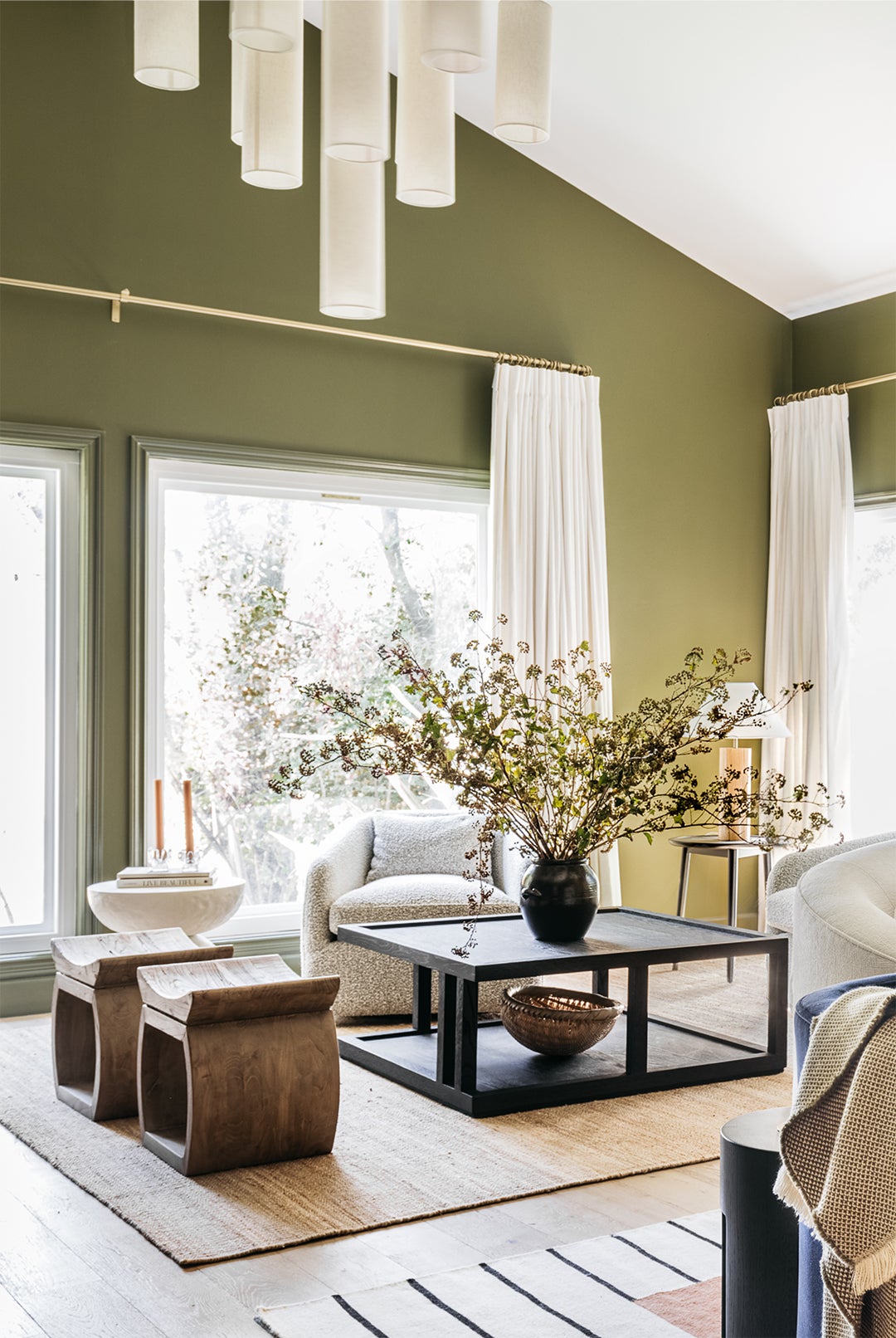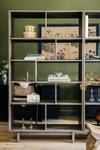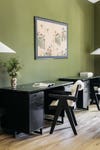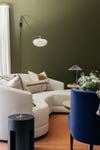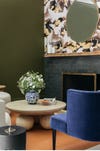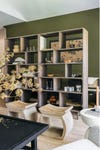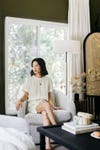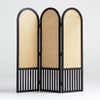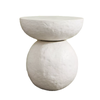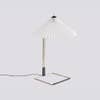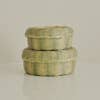A Cane Screen and Two Bookcases Cleverly Divide One Large Living Room Into Three Spaces
No structural changes necessary.
Updated Oct 12, 2018 3:04 AM
We may earn revenue from the products available on this page and participate in affiliate programs.
When California-based designer Grace Lee-Lim pitched splitting up her client’s large living room into three distinct spaces—one home office and two separate seating areas—she and her husband weren’t exactly on board. “They were like: ‘This is so much furniture; are you sure it’s all going to fit?’” recalls Lee-Lim, laughing. The couple and their 3-year-old daughter had recently upgraded from a townhome to a new build just outside of Los Angeles and suddenly had a lot of space to fill (560 square feet in this room alone). Even a mammoth sectional and an equally massive coffee table would feel dwarfed, especially taking the lofty ceilings into consideration. To prove just how much could be done with the huge, empty layout, Lee-Lim devised multiple floor plans—and the family warmed to the designer’s suggestions so much that they gave her complete creative control moving forward.
There weren’t any structural changes required; instead Lee-Lim focused on the strategic placement of furniture. As the mother of a toddler herself, she could relate to the pair’s desire for a place to bask in the quietness of an early morning with a cup of coffee. She carved out that moment of calm near the windows with a formal seating arrangement, complete with swivel chairs to take in the outdoor view. “It’s also nice for a nightcap with guests; the large coffee table grounds the space while also providing an ample place to set drinks and bites (like a large charcuterie board), and two wood stools allow for more seating,” explains Lee-Lim. The designer also created an additional lounge area near the fireplace on the opposite side. Sectioned off by a cane room divider, a curved sectional and circular table help soften things up. “It makes me think of family gatherings and cozy moments together,” she adds.
Figuring out how to fill up extra space wasn’t the only reason the client tapped Lee-Lim for the project. She also liked her distinct approach. The designer defines her aesthetic as a blend of modern and Asian American styles, though she says it’s a look that can be tricky for people to grasp. “The minute you say ‘Asian,’ our minds automatically revert to ‘oriental’ or kitschy in an ’80s, over-the-top kind of way,” she adds. “Why is Asian design attached to that visual?”
Instead of California cool, Lee-Lim’s spaces could easily be described as Korean cool, incorporating organic materials and earthy, neutral tones into simplified designs. She often weaves in traditional Asian touches, such as bamboo seokjak (the basketlike Korean equivalent of Japanese bento boxes) and minhwa (folk paintings), both of which can be spotted on the shelves and in the office, the third area Lee-Lim created. “I’m very influenced by Korean culture,” shares the designer. “My client and I are both Korean American, and we have a shared love for our heritage in all art forms.” In fact, it was the client’s number-one ask: She wanted the room to reflect her grandparents’ California home in an updated way. “She loved the feeling of their place, as they had artifacts from Korea and brought their traditions from their homeland to their new home,” adds Lee-Lim.
It all started with Milton and King’s Cranes wallpaper. Originally, Lee-Lim envisioned installing the aviary pattern as an accent wall, but the large-scale motif felt overwhelming, so the team agreed to pare it down to the area above the mantel. Though they ended up with the Yuri colorway, it was the green in the Midori option that struck a chord with the client. “It gave her this very nostalgic, sentimental feeling, so we ran with it,” says the designer. She painted the room in a similar hue: Palmer Green by Benjamin Moore. “The color was one of the first things we put into the space that she felt a connection to. A lot of the Korean art that I’ve seen and even have myself features that shade. It has a warmth to it; it’s not too blue,” she adds.
Color continued to play an important role while Lee-Lim worked. “There’s an orange square in one of the rugs,” she says, another tactic to visually separate the spaces. Her client described the hue as persimmon, which is considered one of Korea’s national fruits. “She probably grew up eating a lot of persimmons from her grandparents,” says Lee-Lim. Pairing the green and orange created a natural palette that seamlessly tied the room together.
Elsewhere, Lee-Lim incorporated other pieces as nods to her client’s grandparents. What at first glance looks like a typical flowerpot atop the dark coffee table is actually an onggi, a clay storage vessel that can be used to age kimchi; there’s woven wood, from the caning in the screen divider to the sokuri basket, handmade in the countryside of Damyang. And there are Mandarin ducks painted on the vintage silk screen (sourced from Chairish); the ducks are both beloved by the homeowners’ daughter and a symbol of fidelity. (Wedding gifts often feature duck motifs, notes Lee-Lim; peep the porcelain sculpture she found that’s now nestled on the bookcase.)
Whether with paint, decor, or art, Lee-Lim is passionate about figuring out how to blend traditional Asian influences and modern design together in the same place. “What you get is a very beautiful story,” she says. “Bringing elements from the past into the present is so important to me.”
